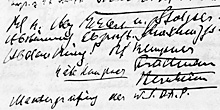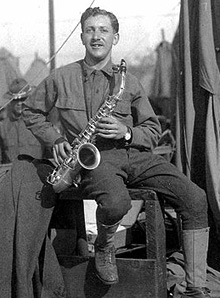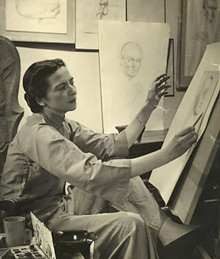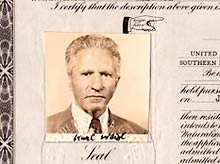Karl Weigl’s Final Years, 1938-1949: A Story of PerseveranceJuliane Brand
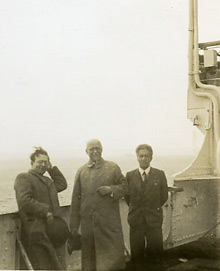
Karl Weigl on board the S.S. Statendam during the transatlantic crossing from Southampton to New York in October 1938.
In 1938 the Viennese composer Karl Weigl was made an exile. Expelled from the geographic, cultural, and spiritual homeland that had until then defined him, his life thereafter followed the template charted by all exile survivors from Nazi Europe. His story, in both its singularities and its commonalities with others, illustrates a period in human history when individuals were at once powerless to change their circumstances and faced with boundless choices on how to live those circumstances.
An account of his story could open on the bright Sunday in March 1938 when German troops marched into Vienna to unprogrammed demonstrations of enthusiasm. The account could just as reasonably open five years earlier, in January 1933, with Hitler's Machtergreifung in neighbouring Germany—or even in 1918, on the day a young woman named Vally Pick appeared at his door to begin private composition studies. For Karl Weigl may never have escaped Nazi Austria had it not been for the energy and determination of the woman who became his second wife.
Wherever the retelling of an exile story is begun, it will be fragmentary and discontinuous. Much documentary evidence is lost, and of what is extant much was selectively preserved by those wishing to pre-empt posthumous interpretation. Narrators may try to resist the temptation to smooth over gaps and ignore discordances, but any retracing of someone else’s story is only one of several that could be constructed. Just as any retelling of a story is shaped by the nature and provenance of information at hand, it is as inevitably shaped by the personality, sensibilities, and choices of the narrator. My hope is that with each telling, the nuance and poignancy of lived experience will refine the exile story template.
![]()
What follows here is a retelling of the final eleven years in the life of one exiled Viennese musician, Karl Weigl. Weigl was a bred-in-the-bone Austrian, a man born and raised in Vienna of Hungarian-born parents; this on paper made him for the first twenty-two years of his life a citizen of Hungary and then for the next fifteen a citizen of Austria—until in 1938 he was stripped of all nationality. He was a man whose religion was on paper for the first forty-five years of his life “israelitisch” (though he never went to synagogue) and then for the next dozen years (still on paper, for he never went to church), a Swendenborgian Protestant—until in 1938 he was assigned to a Judaism to which he felt less connection than to the Quaker community that would help him escape Austria. Perhaps most important, he was a man who had grown up in Central-European traditions and spoke mellow, Austrian-inflected German—until in 1938 he was forced to learn to understand and speak the languages of an entirely new culture.
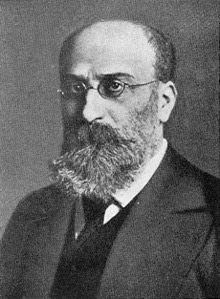
Guido Adler (1855–1941), known as the father of modern musicology.
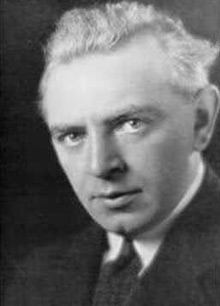
The internationally renowned pianist Ignaz Friedman.
Weigl had learned his compositional craft at the Conservatorium der Gesellschaft der Musikfreunde (later the k.k. Akademie für Musik und darstellende Kunst) with Robert Fuchs and Hermann Grädener, and he earned his PhD in musicology under Guido Adler at the Vienna University.1 For a brief time he was part of the ferment of new music in Vienna. He worked as a repetiteur under Mahler at the Vienna Opera 1904–1906 and joined Schoenberg and Zemlinsky in the short-lived Verein schaffender Tonkünstler. Some of his songs and chamber music were performed in small Viennese venues. But he was just a young local talent until his Symphony No. 1 was premiered at the 1910 ADMV Tonkünstlerfest in Zurich to enthusiastic critical response.2
On the strength of that scheduled performance in an important international forum, Universal Edition had offered him a general contract earlier in 1910, and soon his works were being performed throughout central Europe.3 Major string quartet groups of the day (among them the Rosé, Kolbe, Gottesmann, and Busch Quartets) took up his chamber works. Ignaz Friedman played his Piano Concerto. Hanna Schwarz and Elisabeth Schumann programmed his lieder. In 1928 his career received the official stamp of approval, the honorary title of Professor.
In his musical language Weigl continued traditional Austro-German syntax and tonality, and he worked in large, expansive Brucknerian forms. Not surprisingly, he had come by the mid-1920s to be seen as a “conservative” composer. Until the mid-1930s, however, he was able to live comfortably from performance royalties and private teaching. Then his career, like those of many who depended on performances and sales in Germany, began to dip. His last work to be published in Europe, the String Quartet No. 5 in G Major op. 31, appeared in 1936.4 Increasingly he relied on private teaching.
This slow professional decline is laconically charted in a diary Weigl kept from 1 January 1934 until ten days before going into exile in September 1938.5 In addition to tracking his compositional work, Weigl used the diary to record meetings with friends and colleagues, weekend outings and hikes, and evening activities—occasionally a concert but, more usually, gatherings with friends at their home or “at our place” (bei uns). Only occasionally does he note facts of daily life such as the weather, a tiff with his wife (Krach m[it] V[ally), or the state of his mood. Almost never does he refer to conditions in the larger world, much less to political events. There are, however, several significant exceptions. Early in 1937, in taking stock of the year just past, he wrote:
[A]m not proud of the past year; as to work, only the last movements of the 4th Symphony; long hiatus for months now; many sketches. External conditions bleaker than ever; threat of a new European war immediate (from Spain). Serious increase of anti-Semitism; no chance of a […] performance any time soon.6
He mentions having been in despair in September and, despite a reference to growing public recognition, ends the summary with the words “Future dark” (Zukunft dunkel). A year later, summarizing the year 1937, he again notes “bleak external conditions (war in Spain) […], Nazis in Germany, Anti-Semitism in Austria.”7
Even during the unsettling first two months of 1938, as Austrian autonomy eroded, Weigl, if we are to believe the diary, held fast to his customary schedule and habits.8 On 2 March he notes having played some of his music for Egon Petri, meeting with Willem Mengelberg (4 March), and attending two Petri concerts (7 and 8 March), as well as a rehearsal (7 March) of a performance scheduled for 10 March of the orchestrated version of his Bilder und Geschichten.9 Then on Wednesday, 9 March, starkly interrupting this private record, comes the word “plebiscite!” (Abstimmung!), a reference to Chancellor Kurt von Schuschnigg’s announcement of a national vote with which he hoped to resist Germany’s pressure for unification.10
Two days later, on 11 March, the day the Viennese came to call Black Friday, the Austrian government fell. Countless memoirs describe the effect of Schuschnigg's voice interrupting RAVAG radio broadcasting, at ten minutes before 8 p.m., to announce his resignation and the name of his successor, the Austrian Nazi Arthur Seyß-Inquart. In the hours that followed people milled in the streets, waiting to hear whether the Austrian president, Wilhelm Miklas, would stand firm. Just short of midnight he too resigned, and with that the Austrian National-Socialist Party—that is to say, Germany—controlled the government. Weigl’s diary indicates that he tried to start that day, too, as usual, with Arbeit.11 But it must have been impossible. The entry turns to the events of the day, which he seems to have jotted down as they occurred: first Abstimmung (another parliamentary vote)—that was early in the day. Then Abdankung! (abdication!)—the exclamation point after the word is splay-nibbed with agitation. And, finally, Musterprüfung der NSDAP (draft call for National Socialist troops)—he would not have known about that till the early hours. It seems probable that the Weigls, like so many Austrians, never went to bed that night.
Scrawled untidily amidst these political references are names of friends to whom Weigl wrote immediately upon the cataclysmic events.12 To Toni Stolper, who had emigrated to New York in 1933, Weigl explained, “By the time you receive this letter you will long since know that Hitler has vanquished Austria. […] [M]uch as it pains us, we will need to familiarize ourselves with the thought of emigration. And as I believe that, were the worst to happen, the U.S. offers the only possible solution, I turn to you for advice on how to go about this.”13 Over the next few months the Weigls sent sheaves of letters to an ever widening circle of friends and friends of friends, asking about job prospects in England and the United States and begging for advice. In turn such good friends as Arnold Schoenberg, Artur Bodanzky, Ernst Toch, and above all Ernst Bacon made inquiries on their behalf.
While the Weigls waited for responses— letters between Europe and the United States at that time required between ten and fourteen days—Nazi hysteria in Vienna steadily increased. Less than two months after Schuschnigg had declared that “an abyss separates Austria from National Socialism” Austria was Nazi. All the laws Hitler’s government had incrementally put in place in Germany over the previous five years had become, virtually overnight, Austrian law. The Weigls were spared being picked up in a neighbourhood sweep—it probably helped that they lived in the central first district—but they had their share of pounding fists on the door and abusive behaviour on the streets. Moreover, within two weeks of Anschluß, both Weigls had lost most of their students. As Weigl tells Tess Simpson, the secretary and de facto head of one of the most effective British relief agencies, the Society for the Protection of Science and Learning:
For the same reason we both (my wife and I lost almost all our pupils within 2 weeks, the foreigners leaving Vienna, the others having no money left for music-theory or piano-studies.) — So we have to look out for being able to live and work otherwhere [sic]. As I have different former pupils in England and in the U.S.A., and working-permits f[or] i[nstance] in Holland or Switzerland are still more hopeless to be obtained, I think that only these first 2 countries come in consideration. May I therefore give you some names of best-known musicians who would be able to warrant for my musical qualification as composer and teacher as f[or] i[nstance]: Adolf Busch, Arthur Schnabel, Rudi Serkin, Georg Széll, Bruno Walter, Emmy Heim, Lady Susi Jeans, etc.—or some of my former pupils: (Englishers or well-known as artists) Dr. W.K. Stanton (dir[ector] of the music department of the Radio Birmingham); Dr. J.H. Alden (organist at St. Martins in the Fields); Mrs. Al[ice] Ehlers (the cembalist [...]); Dr. Mosco Carner […] music-critic); Mr. F. Waldmann (conductor and piano-accompanist of the Joos-Ballet […]), etc.14
Given his economic situation, Weigl saw no alternative but to emigrate. The thought that remaining in Austria might be fatal was at that time still inconceivable to almost everyone. The worst that Weigl feared is probably summed up in the letter he wrote to his Dutz-friend Schoenberg: “You know how it is here, that my remaining here would mean not only isolation but also the impossibility of making a living. So, away!”15 (Image: letter to Toni Stoppler.)And yet the information he began receiving in answer to his letters was at first uniformly discouraging. Tess Simpson’s response, which reached the Weigls on 4 April, apparently stated—so Vally wrote to a friend the next day—that the chances of getting a work permit in England were “as good as impossible.”16 The American composer Frederick Jacobi, whom Weigl had written on 9 April, mentioning England’s restrictive policies, responded that circumstances were not much better in his country:
I can well understand your desire to come to America now. Under the circumstances it is perhaps the wisest thing to do. But the situation here is really very, very difficult. We have many of our own excellent musicians unable to find employment and economic conditions here at this moment are not at all favorable. […]
If you should decide to come to America you must be prepared for considerable difficulty and for a wait of perhaps a considerable lapse of time before you find anything.17
Jacobi concluded his letter with the regret that “I wish I did not have to write you so pessimistically, for we all understand the situation perfectly.” But that was the problem: No one outside Austria realized even remotely how dangerous it was for their Austrian friends to remain in a Nazi-controlled country.18
Logistics of emigration
Fleeing with false papers was one option for leaving Austria. Otto Leichter, the husband of Vally’s sister, Käthe Pick Leichter, did so just hours ahead of the border closures that turned both the Ostbahhof and Westbahnhof into scenes of chaos.19 Two other good friends of the Weigls fled a few weeks after the Anschluß for Sweden, later informing the Weigls that
Mitzi and I, by our precipitate decision (to which, however, we had no choice, given the warnings of informed persons), were certainly spared the terrors and indignities to which others were subjected—indeed, the decision saved my life, for at the very hour of arriving [in Sweden …] our apartment, like our beloved Kahlenbergerdorf, was taken over.20
The Weigls chose legal emigration. But if anything was needed to add urgency to their preparations, it was the arrest, on 30 May, of Vally’s sister, Käthe Leichter, who had stayed behind, hoping for legal Ausreise for herself and the two sons, Otto and Franz.21
Those who tried to leave Austria legally faced enormous hurdles and, especially in the beginning, confusion. The various agencies previously involved in arranging Ausreise were responsible for establishing new requirements and adding teeth to existing ones, but bureaucrats were unsure of the new laws and how to deal with the surge of applicants. Undoubtedly many procedures were devised, at quite junior bureaucratic levels, as a means of harassment. But at the policy level of administration the National-Socialist government was above all motivated by the impersonal double intent to rid the country of Jews and strip them of financial assets. In late August 1938, when it had become clear that the chaotic conditions were hindering both goals, Adolf Eichmann was put in charge of the new Zentralstelle für jüdische Auswanderung, a central office for Jewish emigration, which consolidated agencies and streamlined the exit process.
Those in the first wave of applicants, however, were forced to find their way through the bureaucratic thicket by means of painful, time-consuming trial and error. At the time the Weigls began the process, shortly after Anschluß, they would have had to sort through much contradictory information. Every required document necessitated going to a different office, first to procure the form, then to hand it in. Every application required stamps, costing anywhere between eighty groschen and three schillings; many applications called for copies of other documents; face-to-face meetings with officials were also sometimes mandatory. The offices involved in the process were scattered all over the central districts of Vienna, and most had restricted hours. Prospective emigrants thus faced long waits everywhere; photographs from the time show people queuing outside offices all night.22 With the successful acquisition of each new piece of paper or stamp of approval, applicants had to make a designated number of copies, affix new stamps to each copy, and have all the copies notarized. Then the process started over for the next document. Weigl’s handwriting, not good at the best of times, was often downright illegible during this period. Occasionally he apologizes, as in a letter to Toni Stolper: “Please excuse the poor handwriting; my nerves are a bit ragged at the moment!”23
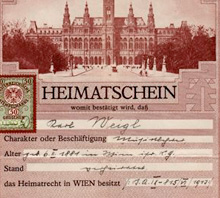
Heimatschein, the document confirming Weigl's residency in Vienna
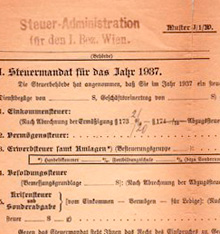
Karl Weigl's tax statement from 1897
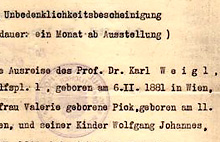
Weigl's fiscal clearance certificate
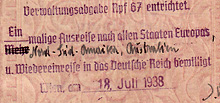
Detail of page of Weigl's Austrian passport
The two most important documents needed to leave Austria were the so-called Steuerliche Unbedenklichkeitsbescheinigung—the fiscal, or tax, clearance certificate—and the official exit permit. Both involved a great many intermediary documents, including many for which Jews had to reapply even if those they already possessed had not expired. Weigl’s previous Heimatschein, often translated as certificate of domicile, the document attesting to his right of legal residence in Vienna,had been issued in 1913 and did not originally require renewal; his post-Anschluß Heimatschein is dated 30 May 1938.24 It was also necessary to certify having paid all local, district, municipal, and national taxes. On 17 June 1938 Weigl received a statement from the tax office of the first Vienna district, where he lived, indicating that he had a credit of 40.86 Reichsmark.25 Weigl of course also had to satisfy the requirements of the Reichsfluchtsteuer (usually translated as Flight Tax), which was based on a December 1931 emergency decree that had gone into effect in Germany during the Weimar period to counter the threat of currency loss during those catastrophic economic times; when the National Socialists took power they reoriented the law toward Jews trying to emigrate. An incomplete collection of bank statements and other documents among the extant Weigl family papers indicates that, like many exiles and despite stringent attempts to prevent out-of-country transfers, the Weigls were able to spirit some funds out of Austria prior to leaving.26
On 8 July 1938 Weigl acquired the fiscal clearance certificate. The document, illegibly signed by an otherwise nameless bureaucrat, has an oddly personal cast, reading, in part: “I have no objections against the exit of Professor Dr. Karl Weigl […] and his wife Valerie, née Pick […] and his children [sic] Wolfgang Johannes.”27 This document was valid for one month. In mid-April Weigl had thought that they could survive in Vienna for perhaps two to three months. Instead, it had taken three months just to achieve financial clearance.
The second major hurdle for leaving Austria, the actual exit permit, for which the Steuerliche Unbedenklichkeitsbescheinigung was both prerequisite and companion piece, required Weigl’s taking his passport to the Wanderungsamt, the office for emigration. There he got a stamp confirming that on 14 July he had been “seen at the Wanderungsamt.” With that stamp in place he was allowed to apply for passport renewal—required even though his passport had previously been valid until 1940. The renewal stamped into the Weigl family’s passports four days later, on 18 July, gave permission to the passport holders to travel to “all countries on earth.” On that same day, on the facing page of the passport—but from a different office—they got the stamp giving permission for “nonrepeatable exit” (einnmalige Ausreise) to “all of Europe, North and South America, and Australia.”
U.S. immigration requirements
It is by now well documented—and new information continues to become available—that the U.S. State Department required its consulates to keep immigration below the quotas that had been set in 1924, which remained in effect for the duration of the European refugee crisis.28 The Weigls were fortunate that John C. Wiley, U.S. consul in Vienna until late July 1938, was more sensitive to the humanitarian aspect of the refugee crisis than many of his colleagues; he seems, in fact, to have walked a fine line, keeping to just within state department guidelines but stretching as many points as he could; he was energetically supported by his wife, the sculptor Irena Wiley.29
The crucial requirement for a U.S. visa was an affidavit of support, in which a legal U.S. citizen or resident vouched for the émigré and declared: “That I am willing and able to receive, maintain, support, and be responsible for the aliens mentioned above while they remain in the United States, and hereby assume such obligations, guaranteeing that none of them will at any time become a burden on the United States or any State, County, City, Village or Municipality of the United States.” Above all it was the public charge clause—one of the oldest and still debated components of U.S. immigration policy after 1917.30—that most often served to justify rejecting applications for asylum. All through April, May, and June Weigl trawled for affidavits. Several acquaintances who declared themselves prepared to sign affidavits for the family did not meet immigration service standards.31 Other acquaintances to whom they applied refused outright, as in this response from a Mrs. Ina Younkers, with whom the Weigls had spent time in Vienna the previous year:
I regret to say it is impossible for me to sign an affidavit for you. I am afraid your information is not correct if you have been told that this is merely a formality.
Our government is very precise and exacting now about affidavits due to the large increase in immigration, and it expects the signers to be financially responsible "for any persons entering the country on such affidavits.”
Also I am sorry to say I do not think it would be at all easy for you to find a suitable position here unless you were directly recommended to one by your friends or pupils. We are in the midst of a serious business depression in the United States and all artists face a very severe struggle for existence.32
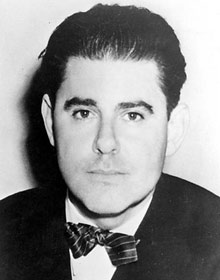
Ira Arthur Hirschmann (1901–19), American business man and patron of the arts.
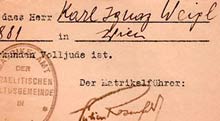
Official documentation that Karl Weigl is Jewish
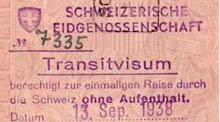


Weigl passport visas for Switzerland, France and England.
In the end it was a total stranger, the New York businessman and music enthusiast Ira Hirschmann, a vice president of Bloomingdale’s, who came through with affidavits for the Weigl family.33
In one more Kafkaesque turn in the path to exile Weigl was required to obtain formal certification from the Israelitische Kultusgemeinde, the official Jewish Community Centre, that he was a Jew. That confirmation came through on 30 August 1938.34 Weigl makes no mention of this in his daily letters to his wife, Vally, who had left Vienna on 23 August to recuperate from a serious bout of pleurisy. During the week she was away Weigl was entirely responsible for completing the preparations for departure.35 One week after her return, on 7 September, the Weigls finally received, stamped into their passports, the three precious U.S. immigration visas, as well as the three corresponding immigrant identification card numbers. Ship passage from England to New York were already secured and paid for, as Weigl had noted in the diary on 10 August. On 5 September the central tax office had extended Weigl’s Steuerliche Unbedenklichkeitsbescheinigung, which was to have expired that day, until the end of September. Now it remained only to make the rounds of the consulates to obtain transit papers for Switzerland, France, and England.36
Even today, to anyone deciphering passages in Weigl’s diary the anxiety emanating from the telegraphic entries is palpable. Yet there are no complaints to be found, and hardly any indications of his feelings. Even on 20 June 1938, the day his daughter marries Gerhart Piers in Switzerland, he comments only by underlining a few words: “Maria’s wedding without my being there” (Marias Hochzeit ohne mein Dasein).37 In August the diary begins to mention farewells to close friends; on 29 August he took what may well have been the last hike in his beloved Wienerwald; the outing was marked by a thunderstorm. (One can only speculate as to whether this sent his spirits soaring or might rather have symbolized the terrors of departure.) The words “last time” and “to say good-bye” (z[um] letztenmal and z[um] Abschied) appear often during the remaining diary entries, which end on 5 October. And then, ten days later, on an unremarkable Thursday morning, 15 September 1938, the Weigl family boarded a train headed for the Swiss border.
Successful exile?
The Weigls could consider themselves lucky to be among those who had been allowed to immigrate legally into the United States.38 They had had a great deal of help from others, but they had needed to draw on all their reserves of resourcefulness and perseverance. While preparing feverishly for emigration, they had surely also to battle grief and anger. They might have been forgiven for thinking that existential worries would ease once they reached safety. But though he soon knew the extent of the danger eluded, Weigl would never again, in the years that remained, feel economic security.
Weigl was almost fifty-eight when he left Vienna. He arrived in New York virtually incognito, and he was granted only eleven years to try to re-establish himself. (See table 1 for a partial comparative list of exiles from Weigl’s circle, giving their ages in the year they emigrated; asterisks indicate the names of Weigl students.) Age at time of exile and subsequent life span were undoubtedly important factors. But apart from that—and luck—the chances for a successful new life were above all determined by the personality of the exile himself.
Karl and Vally Weigl responded to the Anschluß immediately, with pragmatism and energy. There were agitated discussions with family and friends, pro and con—the diary even once mentions “plan postponed”—but within days of the German invasion they had arranged for English tutoring and begun daily piano practise; Weigl occasionally made a note of this, as on 28 March: “Always English and piano” (Immer Englisch u. Klavier).39 From the diary and other written sources it is clear that Weigl understood that he would have to begin anew. He also understood that if anything were to see him through it would be not his composer’s contributions but his musical expertise and abilities as a performer and teacher. What he calls his Arbeitsfeld, his sphere of activity, would never again be the same. To various friends and suggested contacts he lists the different kinds of jobs for which—“according to my abilities,” as he modestly qualifies—he might be considered: “[A]s lecturer or music teacher (theory, composition, history, conductor’s preparation, etc.) at some university or college; as piano accompanist, or examiner, referent [sic] at some music publishers, whatever.”40
Even while still in Vienna he started preparing for the new kind of audience he anticipated encountering. In drafts for music appreciation lectures he summarized Austro-German music history, describing what it will take for the United States to build “a nationwide audience of listeners who will know how to listen to music.”41 The point of view he reveals here—that the land offering sanctuary was culturally backward—was widespread; émigrés to England shared it as well. Beyond preconceptions, however, these drafts also reveal Weigl’s determination to try to make a musical difference—if not through his own works, then through teaching.
The reality of exile
Ernst Krenek once said that the most painful part of exile was echolessness—the lack of resonance for one’s own sensibilities and traditions.42 For Weigl, too, this was a major component of exile. But in the beginning, the Weigls, like most exiles, were most preoccupied with trying to make a living. Although by the fall of 1938 America’s charitable response was fraying, many aid organizations and individuals reached out to help them. “[I]n fact,” Vally wrote to her son less than two weeks after arriving in New York, “almost everyone here has welcomed us most kindly. How incredibly good that feels, after the inhumane, demeaning treatment under the Nazis, eh? — You feel it too, right? — All three of us must be sure never to forget that about this country and its people!”43 Vally needed to communicate with her son in writing because just five days after the family disembarked he had been sent to board with a Quaker family in Connecticut, where he started school. American Quakers, with the help of Toni Stolper, had made these arrangements in anticipation of the difficulties the Weigls would face.44 Apart from a few holidays the boy never again made his home with his parents.
Karl and Vally Weigl had come to the United States with somewhere in the region of $2,800, the extent of their savings. This sum was sufficient to see them through perhaps fourteen or fifteen months. For the entire first year of exile their address was “care of” a Mrs. Oschlag; they were not able to move into an apartment of their own until September 1939. For almost the first two years the only work either of them could find was part-time private teaching.45 Weigl did not get a steady job until fall 1940, when he was appointed to a ten-month-long position at the Julius Hartt School of Music in Hartford, Connecticut.46 But after that job ended in June 1941 Weigl again experienced a hiatus of eleven months before something was cobbled together for him at the New York Public Library, another part-time, temporary job. This pattern was repeated several times, with months’-long stretches of uncertainty between jobs.47
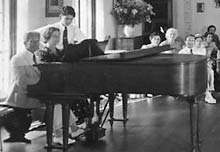
Karl and Vally Weigl at a private musicale, New York, ca. 1939.
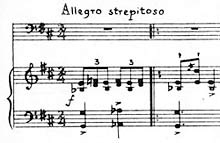
Detail of score, "The Glorious Vagabond"
Weigl had no choice but to spend most of his eleven years of exile teaching, or looking for teaching work, and he was more active as a performer, too, than he had been in Vienna, often appearing together with Vally in four-hand piano performances at musicales in private homes and educational institutions. Yet from the start Weigl continued to carve out time to compose. In the last years before emigration his compositional output had slowed noticeably, probably reflecting his discouragement. Once emigration was unavoidable, however, he not only applied himself energetically to the tasks of transition but also regained the compositional energy that was to sustain him for the rest of his life.
From the documents available it would seem that, at least initially, he approached composing in exile as pragmatically as he had when as a young man he first embarked on a composing career. Then his first works had been single songs (as opposed to the song sets and cycles and, above all, large orchestral works that he composed in his mature European period). Now, in exile, his first works were again single songs. One of these—possibly his first on an English text—is the setting of a boisterous text by Charlotte Storm titled “The Glorious Vagabond.” Similarly defiant in tone is the early 1939 song “The Refugee,” dedicated to the Friends Service Committee, which ends with the words “I am outcast, a refugee, and Christ is born a Jew!” From songs he soon expanded to chamber music. His first larger work in exile was the energetic Piano Trio, dedicated to Ira Hirschmann, followed by the String Quartet No. 6. But for the first two years he limited himself almost entirely to short works for modest performance forces.48 This practical approach paid off: a number of his smaller works, both new and old, were performed fairly regularly during his American years in small public venues, private homes, and occasionally on the radio. (See table 2 for a list of performances and performance venues from one representative year, 1941.)
Yet Weigl regarded himself to be above all a symphonic composer, and already in the spring of 1939 he began writing again for orchestra. Initially, however, even these works show practical considerations of length and substance: the twenty-minute orchestral work Old Vienna (originally titled Dances from Vienna), a seven-minute overture for small orchestra Music for the Young (originally titled Boy Scouts Overture), and, in the following year, a short Summer Evening Music for string orchestra. Not until 1940 did Weigl tackle the more substantial Rhapsody for piano and full orchestra. And then, for three years starting in 1942, he worked on the fifty-minute-long Symphony No. 5. He completed this work, which he titled the Apocalyptic, just before VE-Day, later dedicating it “to the Peoples of the United Nations.”49
Ironically, completing the symphony coincided with learning that his position at the Brooklyn Academy would end that spring.50 This news may well have contributed to Weigl’s becoming seriously ill that spring, which in turn led to a severe depression. He had reason to despair, finding himself, aged sixty-four, yet again without a means of earning his livelihood and again with no expectation of hearing his latest new work performed. By fall, however, Weigl had secured a position at the Boston Conservatory of Music, and in the three years remaining to him, despite long days of teaching and a tiring weekly commute, he managed to complete another handful of significant works.
Like his oeuvre as a whole, these last works—particularly his last big orchestral work, the Symphony No. 6 and the String Quartet No. 8, which he finished just three months before his death—reflect the consistently meticulously crafted, and personal musical language that he had made his own. Increasingly after reaching maturity as a composer in the 1920s, even he lost his cultural support first at home and then in exile, he had become less interested in works written by contemporaries. Indeed, he can be said to have become impervious to new directions and technical means once he had discovered the interrelationship between technique and emotional content that made music “work” for him. The traditional, organic, and masterful architectural structures that Weigl developed in his mature compositions reflect his belief that music is, and should be, independent of changes of fashion. As he wrote in a draft for a talk on music appreciation, music can never be captured in words: what we can study and describe, he says, are musical styles and forms, and it is in understanding those mutable elements that we can grasp and respond to—and, he undoubtedly believed, compose anew—music’s immutable essence.51
It could be argued that Weigl, in continuing in exile to compose works for large orchestra that he knew had but slim chances of being performed, to say nothing of continuing to compose in an “unfashionable” style, adopted a position that ran counter to what common sense would have dictated. It could equally be argued, however, that Weigl was choosing to follow his inner compass.
Among the few other choices open to him at this time was whether or not to remain in the United States after the defeat of Nazism. Austria, unlike Germany, was remiss in encouraging its émigrés to return after 1945, but many nevertheless did so, or tried to. The Weigls, however, had acquired U.S. citizenship in January 1944—having applied almost immediately upon arriving—and never considered returning to Europe. Both of Weigl’s children had become settled, and there were two grandchildren before Karl Weigl died in 1949. Equally important, Weigl had learned to love the natural beauties of the United States. Living less than one short New York city block from Central Park had done much to mitigate the loss of his beloved Wienerwald, and frequent outings to the Adirondacks and a trip to the mountains of the West cemented his sense of connection to his new homeland.
![]()
Presumably most composers write with the hope for applause and recognition, but even more important for many may be the very act of composing. Like all exile survivors Weigl recognized how profoundly his life had been redirected by external circumstances. His several serious depressions attest that he was occasionally paralyzed by the conviction that his life was one of strangled potential. Yet though during his last eleven years he was never free from economic worry, and labouring harder than had ever been necessary before, his corpus of completed works testifies to his having refused to allow the echolessness of exile or the near-extinction of his name to interfere with the pursuit of his chosen craft.
How the composer himself may have regarded the matter can perhaps be conjectured from a 1945 letter to Vally, in which he took stock:
I know that in addition to all the other difficulties I also have to compete with the younger generation. Nevertheless I believe that, at least potentially, I was their equal, or would have been, if not for—etc.
It is the situation, scarcely to be envied, of Baumeister Solness, thwarted in his development but yet able to earn the laurel wreath [Kranz]—as recently demonstrated.52
In comparing himself to Ibsen’s Baumeister Solness, the Master Builder—who achieved his early ambitions by surpassing his elders but then himself begins to be surpassed by, and eventually falls victim to, the younger generation—Weigl seems to indicate that he knew he was no longer a player in the competitive arena. At the moment of writing he may even have thought that he had reached his creative end; after all, Solness falls to his death in trying to place a Kranz, or laurel wreath, on his last building. Nevertheless Weigl expressed confidence that with this just completed Symphony No. 5 he has once again earned a master’s laurels. Surely in striving, with each new work, for the unattainable perfection of a master builder, he lived a life not just of perseverance but also of choice.
Notes
1. His graduation certificate from the Conservatorium, dated 15 July 1902, gives him the highest passing grade (vorzüglich, or excellent) and notes his receiving that year’s silver medal for composition. He received a PhD on 22 May 1903 for his dissertation on the life and work of Emanuel Aloys Förster (1748–1823), a study on which a few years later he based his “Emanuel Aloys Förster,” Sammelbände der Internationalen Musikgesellschaft 6, no. 2 (January 1905), 274–314.
2. Weigl’s Symphony No. 1, completed in 1908, was performed by the Zurich Tonhalle Orchestra, conducted by Volkmar Andreae, on 28 May 1910, as part of that year’s ADMV Tonkünstlerfest. See reviews by, among others, H.W. Draber in Die Germania (Berlin, 1 June 1910), Heidelberger Tagblatt (1 June 1910), and Grazer Tagespost (2 June 1910); also see Signale für die Musikalische Welt (1910), 876; Alexander Weißmann in Württemberger Zeitung (30 May 1910); Paul Bekker, “Das 46. Tonkünstler-Fest des Allgemeinen Deutschen Musikvereins in Zürich (27.–31. Mai 1910),” Die Musik, 10 (1910), 372–77; E. von Binzer, “Musikbriefe: Zürich, 46. Tonkünstler-Versammlung des Allgemeinen Deutschen Musikvereins 27.–31. Mai 1910,” Neue Zeitschrift für Musik (1910), 123–25; Oswald Kühn, “Vom Tonkünstlerfest in Zürich,” Neue Musik-Zeitung 18, no. 31 (1910), 379–381; Leopold Schmidt, “Vom Zürcher Tonkünstlerfest,” Berliner Zeitung (27 May 1910); and Walter Paetow, “Das Deutsch-Schweizerische Tonkünstlerfest,” Tägliche Rundschau, Berlin 128 (4 June 1910), 511.
3. In this standard ten-year contract, signed on 11 February 1910, Weigl gave Universal Edition Prioritätsrecht (first right of refusal) to all of his nondramatic works for the next ten years.
4. Universal-Edition No. 10.974. The Busch Quartet (Adolf Busch, Gösta Andreasson, Karl Doktor, and Hermann Busch), to whom the work is dedicated (“Dem Busch-Quartett in dankbarer Verehrung”), had given the premiere performance in Vienna on 23 November 1934. The work received a number of subsequent European performances, including one on 9 May 1936 in Vienna by the Weiss Quartet (Lilly Weiss, Lotte Selka, Edith Steinbauer, and Frida Krauss), who took the work on their next season’s tour in England and repeated the work again in Vienna on 16 December 1937, one of the last Weigl performances in Europe before his emigration.
5. The notebook in which Weigl documented his daily activities, approximately 7.5 inches high by 12 inches wide, bears a small label with the dates: 1934—1935—1936—1937—1938. MSS 73, The Papers of Karl Weigl in the Irving S. Gilmore Music Library of Yale University, Series VIII, Box 29, Folder 926 (in future Karl Weigl Papers, YU); to access the finding aid for the Weigl Papers, see http://hdl.handle.net/10079/fa/music.mss.0073. The diary gives a good overview of Weigl’s daily activities and concerns because, though the jottings are telegraphic, Weigl rarely missed a day (or if he did, he filled in the skipped days afterwards, as changes in ink tint or thickness occasionally indicate). Almost all but Sunday entries—that day is almost always devoted to hikes and outings—begin with a reference to Arbeit, or work. As Weigl used it, the word Arbeit invariably referred to musical work—sketching, composing, orchestrating, or copying out scores and parts. Often Weigl notched off the day’s allotment of work merely with the abbreviation Arb or by carrying the reference over from a line above with a crow’s-feet symbol; he seems usually to have worked on only one composition at a time, and he generally named the work in progress only upon first beginning and then again after completing it.
6. “[M]it dem abgelaufenen Jahr […] wenig zufrieden; von Arbeiten nur die letzten Sätze der IV. Symphonie; seit Monaten große Pause; viele Skizzen. Äußere Verhältnisse trüber denn je; Gefahr eines neuen europäischen Krieges unmittelbar drohend (aus Spanien). Starkes Anwachsen des Antisemitismus; dzt. keine Möglichkeit einer [illegible word] Aufführung.” Entry dated 3 January 1937.
7. “Trostlose äußere Verhältnisse (Krieg in Spanien […], Nazi in Deutschland, Antisemitismus in Oesterr[eich].” Entry dated 31 December 1937.
8. Already in January, however, writing to his former student and friend Ernst Bacon (1898–1990), he referred to “the external events that are admittedly reaching deep into one’s private life! [die äußeren Verhältnisse, die allerdings tief in das Privatleben eingreifen!].” Letter dated 13 January 1938, Ernst Bacon Papers, Special Collections M0906, Stanford University.
9. The performance of Bilder und Geschichten took place in the Großer Ehrbarsaal with the Wiener Konzertorchester, Rudolf Fellner conducting.
10. For two detailed accounts of the Austrian experience in March 1938, see Thomas Chorherr, ed., 1938—Anatomie eines Jahres (Vienna: Verlag Carl Ueberreuter, 1987), and Dokumentationsarchiv des österreichischen Widerstandes, “Anschluss" 1938: Eine Dokumentation, ed. Heinz Arnberger, Winfried R. Garscha, et al. (Vienna: Österreichischer Bundesverlag, 1988).
11. A crows’-foot carry-over of Arb is followed by an exclamation point and a faintly scrawled and heavily abbreviated phrase that might be “Erinnyentanz,” the piano piece he had been working on as of January of that year.
12. Weigl used his customary abbreviation for letter, Bf (for Brief); the names entered, some underlined, include those of his childhood friend Kate Kempner, who had emigrated to the United States several years earlier; the harpsichordist Alice Ehlers, who had left Vienna for the United States in 1936; someone named Sternheim; and the economist Antonie (Toni) Stolper. Two other names remain to be deciphered.
13. “Wenn Sie dieser Brief erreicht, wissen Sie schon längst von Hitlers Sieg über Österreich! [...] Aber trotzdem müssen wir—wie sehr es uns schmerzt—uns mit dem Gedanken der Auswanderung vertraut machen. Da ich glaube, dass im Ernstfall nur U.S.A. in Betracht kommt, bitte ich zunächst um Ihren Rat, wie das anzupacken wäre.” This letter and others from Weigl, as well as some carbon copies of Stolper’s letters to him, are preserved in the Toni and Gustav Stolper Collection AR 7212 F AR 7212, Leo Baeck Institute, New York (in future Stolper Collection, LBI). Four letters from Stolper to Weigl are available in the Karl Weigl Papers, YU; two others from this time are in the Karl Weigl Foundation archives, San Rafael, California (in future KWF). Stolper’s first response to Weigl, dated 4 April 1938, is reproduced (on the basis of a copy in LBI, the original apparently lost) in Horst Weber and Stefan Drees, eds., Sources Relating to the History of Emigre Musicians 1933–1950, vol. 2, New York (Munich: Saur Verlag, 2005), 377–79.
After emigrating to New York with her husband, Gustav Stolper, Antonie Stolper (1890–1988) had founded Selfhelp for German Refugees and worked with the refugee organization American Council for Émigrés from the Professions. She worked valiantly to help the Weigls, as is evident from her correspondence with her brother, Karl Kassowitz, a former student of both Alban Berg and Weigl, and her close friend Lilly Toch; see Ernst Toch Archive, 1, Performing Arts Special Collections, University of California, Los Angeles; finding aid at http://content.cdlib.org/view?docId=ft0z09n428&chunk.id=c02-1.2.9.2.8&query=toni%20stolper&brand=oac. For her reminiscences from this time, see Toni Stolper, Ein Leben in Brennpunkten unserer Zeit, Wien, Berlin, New York: Gustav Stolper 1888-1947 (Tübingen: Rainer Wunderlich Verlag, 1960).
14. Letter dated 26 March 1938 (photocopy of carbon copy, KWF), one of the first letters Weigl penned in English. It is reproduced here almost in its entirety because it is representative of many similar letters Weigl sent out. The Society for the Protection of Science and Learning was the name given in 1936 to the Academic Assistance Council (AAC), which had been set up in 1933 to assist German academics to relocate; the organization was instrumental in offering refuge in England to a range of scholars, artists, and intellectuals. For more information, see Esther Simpson, Refugee Scholars: Conversations with Tess Simpson (London: Moorland Publishing, 1992).
15. “Du weißt, wie es hier steht, daß Hierbleiben für mich nicht nur Vereinsamung bedeutet sondern auch die Unmöglichkeit eines weiteren Erwerbes. Also weg!” Letter of 31 March 1938, Arnold Schoenberg Collection, Library of Congress.
16. Letter dated 5 April 1938, addressed to “Mimi” (photocopy of carbon copy, KWF).
17. “Ich weiß, dass ich zu allen anderen Schwierigkeiten auch noch den Kampf gegen eine jüngere Generation zu bestehen habe. Trotz allem glaube ich, dass ich potentiell mindestens eben so viel gewesen bin oder geworden wäre, wenn nicht—etc.
“Es ist die wenig beneidenswerte Lage eines in der Entwicklung gehemmten Baumeister Solness, der aber immerhin noch imstande ist, den Kranz auf seiner höchsten Person zu tragen—wie sich vor kurzem gezeigt hat.” Letter to Vally Weigl dated 5 July 1945 (KWF).
18. Even Toni Stolper, a native of Vienna, was unable correctly to gauge the changes the city had undergone since the Anschluß. In a letter of 24 June 1938 (LBI) she recommends the option—suggested by a distant relative of Vally Weigl, Leonard Pick—that Weigl leave Vally and Wolfi in Vienna for the time being and emigrate alone: “This has much to recommend it. Alone you will be much more unencumbered, can travel if necessary, and only you will need to incur the high expenses of life in America. […] I can imagine that separating would not be an easy decision for the three of you, but many other immigrants have chosen this path to great advantage. [Diese Anschauung hat praktisch zweifellos viel fuer sich. Sie sind hier beweglicher, wenn Sie allein sind, koennen reisen, wenn es noetig ist, und der teure amerikanische Boden wird zunaechst nur fuer Sie in Anspruch genommen. […] Ich kann mir denken, dass eine Trennung fuer alle drei kein leichter Entschluss ist, aber viele der Einwanderer haben denselben Vorgang mit Nutzen gewaehlt.]” Stolper cites the example of Fritz Stiedry, whose wife held off coming to New York until he was offered the position of conductor of the just founded New Friends of Music Orchestra. Among the European community Stiedry’s luck in being offered this position within four weeks of arriving in New York became the legendary exception to the rule of the exile experience; in an earlier letter to Weigl, Toni Stolper refers to Stiedry as a Glückspilz, a lucky chap.
19. Both Otto and Käthe Leichter were important figures in the Austrian Socialist Workers Party, which had been illegal since 1936. Otto, a lawyer by training, worked for the party as a journalist and publicist. In his first attempt to leave Vienna on 14 March 1938 he was turned back at the Yugoslavian border, but on the following day he managed to cross into Czechoslovakia, and eventually got safely to Paris.
20. “Mitzi und ich, wir haben sicher durch unseren raschen Entschluss, zu dem wir allerdings durch Warnungen Bestinformierter geradezu gezwungen wurden, nicht nur aller Schauer und Entwürdigungen erspart, denen die Zurückgegbliebenen aller Schattierung ausgesetzt waren, mehr noch, der Entschluss hat mein Leben gerettet, denn zur Stunde unserer Ankunft [...] wurde ich schon gesucht, war das liebe Kahlenbergerdorf schon ebenso beschlagnahmt wie unsere Wohnung.” Letter dated 25 February 1940 from friends named Mitzi and Otto (no surname available), who found refuge in Stockholm; Karl Weigl Papers, YU.
21. Käthe Leichter, one of the first European women to earn a PhD in law, had made a name for herself writing on the subject of women's work and was head of the women's division of the Vienna Arbeiterkammer, a governmental agency for labour and social affairs. She was picked up by the Gestapo on the day she tried to leave Vienna illegally. She was almost certainly betrayed by a family acquaintance. Initially held in a number of Viennese prisons, she subsequently spent more than two years in the concentration camp Ravensbrück before being transferred in early 1942 to the so-called psychiatric institution Bernburg an der Saale, where she was murdered in March of that year. See Herbert Steiner, ed., Käthe Leichter: Leben und Werke (Vienna: Europa Verlag, 1973); Rochelle G. Saidel, The Jewish Women of Ravensbrück Concentration Camp (Madison: University of Wisconsin Press, 2004); and the heart-wrenching collection of letters written to her from Paris by her husband, Otto Leichter, Briefe ohne Antwort: Aufzeichnungen aus dem Pariser Exil für Käthe Leichter 1938-1939 (Böhlau Verlag, 2003). See also Otto Leichter, Zwischen zwei Diktaturen: Österreichs Revolutionäre Sozialisten 1934-1938 (Vienna: Europa Verlag, 1968); and the memoir of one of the Leichter sons, Henry O. Leichter, Eine Kindheit: Wien—Zürich—Paris—USA (Vienna: Böhlau Verlag, 1995). For a discussion of the relationship between Käthe Leichter and her sister, see Margit Wolfsberger, “Käthe Leichter und Vally Weigl: Zwei Schwestern, zwei Autobiographien, eine schwierige Beziehung,” Give Them Music: Musiktherapie im Exil am Beispiel von Vally Weigl, ed. Elena Fitzthum and Primavera Gruber (Vienna: Edition Praesens, 1993), 70–81.
22. See, for example, photograph reproduced in “Central Office for Jewish Emigration in Vienna: Wilhelm Hoettl, Testimony Given for the Trial of Adolf Eichmann,” www.holocaustresearchproject.org/nazioccupation/hoetll.html; accessed 30 May 2009.
23. “Entschuldigen Sie die schlechte Schrift; die Nerven sind derzeit etwas in Unordnung!” Letter dated the Saturday before Easter, Ostersamstag 1938 [16 April 1938]; Stolper Collection, LBI.
24. Copies of Weigl’s Heimatschein, as well as the other documents described below, are located in the KWF archives, San Rafael, California.
25. According to this document he had paid 81.44 Reichsmark to cover taxes of 27.06 Reichsmark on his 1937 salary of 2,000 schilling, and an additional 13.52 for the first two quarters of 1938. A subsequent confirmation receipt (Emphangschein) dated 29 July 1938 indicates that he paid an additional 40.40 Reichsmark to the same office for taxes owed in June 1938.
26. Primus Bon, whom Weigl mentions saying good-bye to in a diary entry of 4 April (a “trauriger Föhnsonntag,” a Sunday with föhn, or chinook winds), served as their banker in Switzerland. Karl Weigl had two Vienna bank accounts, one with his mother as co-signatoree, which he closed in April 1938, and both Weigls had German rail and British war bonds that they had sent to Switzerland on 28 March care of Primus Bon. When they stopped off in Basel on their final route into exile, Bon arranged for the Bank für Anlagewerte in Zurich to cut one check for $1,799.78 (this was sent to the New York address of Dr. Wilhelm Eitner, a Viennese friend of the Weigls who had emigrated to the United States in the 1920s) and one cheque for $1,000 (this, in addition to ten pounds in English currency, was remitted to them in Basel by messenger). With these funds the Weigls were able to make the journey and survive in New York during the initial year of exile. In later years Vally Weigl wrote that her savings from working in Amsterdam in 1921 had provided the “emergency backlog” to “start life anew” in exile: “The night after the ‘Anschluss’ I transferred it to the father of one of our students in Switzerland [probably Primus Bon, mentioned above] who later could send it to us in New York, so we had then not only the 10 Marks we could take along in leaving Vienna and felt not quite as lost and insecure.“ Vally Weigl, undated typewritten manuscript titled “Early Childhood Recollections,” KWF. Vally Weigl may have been referring to the 934 Swiss francs (a bit more than 200 contemporary U.S. dollars) that she deposited in her name to the Swiss Kreditanstalt in Zurich on 16 December 1937 and 17 March 1938.
27. “Gegen die Ausreise des Prof. Dr. Karl Weigl, Wien, I. Rudolfspl[atz] 1, geboren am 6. II. 1881 in Wien, und seiner Ehefrau Valerie geborene Pick, geboren am 11. IX. 1894 in Wien, und seiner Kinder [sic] Wolfgang Johannes, geboren am 1. VIII. 1926, habe ich keine Bedenken.” According to the notarized carbon copy that Weigl retained in his possession, the signature of the official who granted the exit permission was “illegible” (unleserlich), on the original document.
28. In 1917 Congress had passed a bill “Regulating Immigration of Aliens to, and Residence of Aliens in, the United States,” in which for the first time the country’s open-door policy was overturned in favour of quotas based on previous immigration records; these quota figures were revised in 1920 and again in 1924. After the international conference of thirty-two countries in Evian, France, in July 1938, called into existence by President Roosevelt, the United States announced that it would not raise the quotas established in 1924. The maximum number of immigrants permitted jointly from Germany and Austria thus remained at 27,370 immigrants per year (the sum of the Austrian quota, 1,413, and German, 25,957); this figure is given in various sources, including President Herbert Hoover’s Proclamation 1872 of March 22, 1929, “On the National Original Immigration Quotas,” reproduced in Michael C. LeMay and Elliot Robert Barkan, U.S. Immigration and Naturalization Laws and Issues (Westport, CT: Greenwood Press, 1999), 163–64; for an online source see also Laura M. Miller, "Proclamation on Immigration Quotas (28 April 1938)," Dictionary of American History (The Gale Group Inc., 2003, www.encyclopedia.com/doc/1G2-3401804817.html; accessed 29 July 2009); and Suzanne Stone, “Refugee Crisis of 1938” (http://history.sandiego.edu/gen/st/~stone/Refugee.html; accessed 4 November 2008). According to the United States Holocaust Museum, by late 1938 there were 125,000 applicants for the ca. 27,000 available visa ("The Holocaust," Holocaust Encyclopedia, www.ushmm.org/wlc/en/index.php?ModuleId=10005143; accessed 2 February 2008). After the United States declared war in 1941 refugees from Nazi Germany were labelled as “enemy aliens.”
The extensive body of literature dealing with this subject includes Henry Feingold, The Politics of Rescue: The Roosevelt Administration and the Holocaust, 1938-1945 (New Brunswick, NJ: Rutgers University Press, 1970); Saul S. Friedman, No Haven for the Oppressed: United States Policy toward Jewish Refugees, 1938-1945 (Detroit, MI: Wayne State University Press, 1973); Michael C. LeMay, ed., The Gatekeepers: Comparative Immigration Policy (New York: Praeger, 1989); David S. Wyman, Paper Walls: America and the Refugee Crisis, 1938-1941 (New York: Panthean Books, 1985); and Bat-Ami Zucker, In Search of Refuge: Jews and U.S. Consuls in Nazi Germany, 1933-1941 (London: Vallentine Mitchell, 2001). See also Melissa Jane Taylor, “Bureaucratic Response to Human Tragedy: American Consuls and the Jewish Plight in Vienna, 1938–1941,” Holocaust and Genocide Studies 21, no. 2 (2007), 243–267.
29. John Cooper Wiley (1893–1967) was consul general in Vienna from December 1937 until 18 July 1938; the Papers of John Cooper Wiley, including diplomatic files, general correspondence, personal documents, and writings, are available at the Franklin D. Roosevelt Presidential Library and Museum. See also Irena [Baruch] Wiley’s memoir, Around the Globe in Twenty Years: An Artist at Large in the Diplomatic World (New York: David McKay, 1962), who recounts (78) that her husband ordered twenty-four assorted telephone directories from New York and Chicago to help would-be U.S. immigrants locate relatives who might agree to sponsoring their application. Given that “[i]t was impossible to help everyone,” she herself “decided in so far as possible to concentrate on artists.” A number of exiles, including, perhaps most prominently, Sigmund Freud, owe their escape from Vienna directly to her. Karl Weigl’s diary several times (including 25 April and 19 July) mentions meetings with “Mrs. Wiley,” who suggested that he write to a number of musicians with positions at U.S. academic institutions.
30. See, for example, James R. Edwards Jr., “Public Charge Doctrine: A Fundamental Principle of American Immigration Policy,” Center for Immigration Studies (May 2001), http://www.cis.org/articles/2001/back701.html; accessed 8 March 2008.
31. One of the Weigls' acquaintances in New York, Albert Tanzer, owner of the export firm Pan-America Fur Corporation, was willing to sign an affidavit for Karl Weigl's mother but failed because, as he tells them in a letter of 29 August 1938 (KWF), he “does not possess the required qualifications [weil ich nicht die erforderlichen Qualifikationen besitze].”
32 Typed letter without envelope, dated 20 May 1938 (KWF).
33. In July the Weigls learned that the affidavits had been secured; Toni Stolper wrote on 6 August 1938 to express her satisfaction at receiving the news in what must have been an undated letter (she acknowledges the “letter of ? July”). Ira A. Hirschmann (1906–1989) had in 1936 founded a successful nonprofit organization, New Friends of Music in New York, to sponsor performances of chamber music. Later, Hirschmann was a prominent member of the War Refugee Board and helped to rescue Jewish refugees while serving as President Roosevelt’s special envoy to Turkey in 1944. See the Ira Hirschmann Papers, 1934-1969, New York Public Library, Music Division (www.nypl.org/research/manuscripts/music/mushirschmann.xml). See also various books by Ira Hirschmann, including his posthumously published Obligato: Untold Tales from a Life with Music (New York: Fromm International, 1994) and his Life Line to a Promised Land (New York: Vanguard Press, 1946), which he dedicated “To the survivors of Hitler’s hate, who will most deeply love, and live for, freedom.” Several items of correspondence (Karl Weigl Papers, YU, and KWF) attest to a loosely maintained connection between Hirschmann and the Weigls after their arrival in New York.
According to Kurt Adler (1905–1988), the conductor and longtime director of the San Francisco Opera, it was Irena Wiley who persuaded Ira Hirschmann to issue the affidavits; see Adler, “Dear M & A (a letter from Kurt Adler, Conductor and Chorusmaster of the Metropolitan Opera; Advisory Board Karl Weigl Memorial Fund),” Music & Artists 1, no. 4 (1968): 26–27, and the four-page typescript draft for this article, with handwritten additions (KWF). Adler, who had studied with Weigl in the 1920s, went into American exile on the same boat, the SS Statendam, that took the Weigls from Southhampton to New York in October 1938. He remained a strong supporter of Weigl for the rest of his life.
34. This document was apparently required by a Viennese Militärbehörde at the time of exit; the simple half sheet of paper carrying the certification was issued to Weigl and notarized by the Israelitische Kultusgemeinde (IKG) on 29 August 1938 upon submission of unspecified documents, presumably including Weigl’s birth certificate, and approved one day later with a stamp from the Wehrbezirks-Kommando (defense commando) of Vienna. Weigl’s parents had registered him with the IKG at birth, according to a document dated 20 September 1899 that registered him for future military service upon graduation from Gymnasium. The IKG, established in 1852 by decree of Emperor Franz Josef I, had for decades served as the main spiritual, cultural, and educational centre for Vienna’s Jews. After the Anschluß the organization was coopted by the National-Socialist government to collaborate in the forced expulsion and deportation of Jews. For more information on the IKG, see Felicitas Heimann-Jelinek, Lothar Hölbling, and Ingo Zechner, Ordnung muss sein: Das Archiv der Israelitischen Kultusgemeinde Wien (Vienna: Jüdisches Museum Wien, 2007).
35. Vally Weigl had been diagnosed with pleurisy on 2 July and for the rest of that month Weigl’s diary contains almost daily references to her steadily worsening condition. On 1 August he was finally able to note that she was better, and later that month she travelled by train to Semmering, a mountain town and popular spot for lung patients about 100 kilometers south of Vienna. While away, Vally Weigl sent copious advice and directives on what was to be packed, what sold, and what given away. Corresponding during this time entirely in English, she closed one of her first letters, dated 25 August 1938, with the words “For today kindest regards and write every day about everything, will you? Your English was very good, only you still mix up then and than. Ever yours Vally.”
36. On 9 September the transit visa for England came through—“ Good for single journey only”; three days later the passports were stamped by the French consul in Vienna for transit sans arrét;and one day after that, on 13 September, they received their transit visa for Switzerland, for “einmalige Reise durch die Schweiz ohne Aufenthalt.
37 When Maria Weigl and Gerhart Piers left Vienna for Switzerland on 29 March, several weeks before the Swiss border closed, Weigl had given her his compositional autographs to keep until he could pick them up.
38 The actual number of immigrants varies with the source consulted. According to Peter Eppell, Österreicher im Exil, USA 1938–1945: Eine Dokumentation, vol. 1 (Vienna: Dokumentationsarchiv des österreichishen Widerstandes, 1995), 28, possibly circa 30,000 Austrians entered the United States between March 1938 and December 1941, when the United States declared war on Germany; that same source cites the number given by the Israelitische Kultusgemeinde in Vienna for the period between 13 March and mid-November 1941 as 28,615.
39. Toni Stolper repeatedly reminded them how important this was, as in a letter, dated 24 June 1938, where she wrote: “For the time being I can only keep repeating my most important piece of advice: that learning English remains your top priority. Nothing you do or don’t do in the meantime is nearly as important [Einstweilen kann ich nur immer und immer wieder meine wichtigsten Rat wiederholen: alle Kraefte eingesetzt fuer das Studium des Englischen. Nichts, was Sie in der Zwischenzeit tun oder nicht tun, ist annaehernd so wichtig].”
40. A number of carbon copies of letters from Weigl addressed to “Dear Sir,” or “Sehr geehrter Herr Professor” include suggestions of this sort. The list here is from a letter to Frederick Jacobi of 9 April 1938 (carbon copy, Karl Weigl Papers, YU). In most of these letters Weigl also describes Vally Weigl’s qualifications as pianist and teacher; in his first letter to Tess Simpson, Weigl wrote: “As to my wife, Valerie Weigl, she has not only her States-examination for piano and music-theory and was assistant teacher of the famous Prof. Robert in Vienna; but she also worked as translator for English, German, French (a little Italian and Dutch) in Amsterdam and would consent to take what job ever as teacher for piano or harmony, as translater [sic] or secretary, as lady-companion or travelling-companion, whatever obtainable.” Letter dated 26 March 1938 (photocopy of carbon copy, KWF). Weigl never referred to her credentials as composer (she had studied composition with him), but she began composing seriously in the first years of exile and by the end of her life had completed a large corpus of works, many of which have been performed and recorded. For more information, see Sophie Fetthauer, “Vally Weigl,” Lexikon verfolgter Musiker und Musikerinnen der NS-Zeit, http://cmslib.rrz.uni-hamburg.de:6292/receive/lexm_lexmperson_00001012;jsessionid=r2u665b89y7s?wcmsID=0003, a still ongoing project of the Musikwissenschaftliches Institut, University of Hamburg; accessed 10 July 2009. Also see Elena Fizthum and Primavera Gruber, eds., Give Them Music: Musiktherapie im Exil—Am Beispiel von Vally Weigl, Wiener Beiträge zur Musiktherapie 6 (Vienna: Praesens, 2003).
41. Typescript titled “Appreciation of Music,” in notebook of writings; n.d. (Karl Weigl Papers, YU, box 25, folder 817).
42. Ernst Krenek, "America's Influence on Its Composer,” Perspectives of New Music 8, no. 2 (Spring–Summer, 1970), 112–17, translated by Don Harran, from Krenek, "Amerika's Einfluss auf eingewanderte Komponisten,” Musica 12 (1959), 757–61.
43. “[Ü]berhaupt fast alle Leute hier kommen uns ungemein lieb entgegen. Wie wohltuend ist das nach der menschenunwürdigen Behandlung under den Nazis, gelt!? — Du spürst’s ja auch, nicht wahr? — Und das wollen wir dem Land und seinen Bewohnern alle drei nie vergessen!” From Vally’s letter to John Weigl, dated 20 October 1938 (KWF)
44. On 16 September 1938 Toni Stolper had written to the Weigls’ Vienna address, also sending a copy of the letter to the SS Statendam: “I hope that before you leave you and your wife will receive the good news I was just told by your friend Mrs. La Farge. She suggests that your son be placed for a few months at an apparently excellent private school, Glenacres School in Roxbury, Connecticut. Her husband taught at this school and is a friend of the director, Mr. Martin, who lived in Germany for six years and is happy to accept a well-recommended immigrant child. It appears that Mr. Martin will pay your son's tuition costs and Mrs. La Farge his living expenses.” (Ich moechte gern, dass Sie und Ihre Frau vor der Abreise die erfreuliche Nachricht erhalten, die mir eben Ihre Freundin, Mrs. La Farge, gibt. Sie schlaegt vor, dass Ihr Sohn fuer einige Monate auf ihre Kosten in einer anscheinen ausgezeichneten Privatschule, Glenacres School in Roxbury, Connecticut, untergebracht wird. Ihr Mann hat an dieser Schule selbst unterrichtet und ist mit dem Leiter, Mr. Martin, befreundet. Dieser hat sechs Jahre in Deutschland gelebt und ist mit Freuden bereit, ein gut empfohlenes Emigrantenkind aufzunehmen. Er scheint, dass Mr. Martin die Kosten fuer den Lehrfreiplatz und Mrs. La Farge die fuer den Unterhalt Ihres Sohnes tragen wollen.) Karl Weigl Papers, YU.
The Weigls’ connection with the Quaker community had begun in Vienna, where the Vienna Quaker Center headed by the American Emma Cadbury was instrumental in helping them put together their exit and immigration applications; Cadbury also provided cards of introduction to Quakers in the United States (see letter to Karl Weigl dated 26 September 1938, KWF). In New York the Weigls became members of the Wider Quaker Fellowship (membership cards, KWF), and the connection to the Quaker community remained strong.
For a general overview of Quaker contributions to the Jewish refugee effort, see Hans A. Schmitt, Quakers and Nazis: Inner Light in Outer Darkness (Columbia: University of Missouri Press, 1997).
45. Among Weigl’s first students in New York was the internationally renowned violinist Roman Totenberg, who had relocated to New York from Paris a short time earlier and wished to deepen his understanding of harmony and counterpoint (private interview, 12 June 2003).
46. Between 16 September 1940 and 14 June 1941 Weigl was hired to teach ten to eleven hours a week for a total salary of $1,800, paid in ten monthly installments. The position was secured for him by the Emergency Committee in Aid of Displaced Foreign Scholars Records, formed in New York in May 1933 by American academicians wishing to help relocate exiled European scholars (upon its dissolution in 1946 the organization donated the voluminous papers documenting its activities to the New York Public Library; see www.nypl.org/research/chss/spe/rbk/faids/Emergency/index.html). Weigl’s position at the Hartt School was partially underwritten by the Oberlander Trust, part of the National Carl Schurz Association, which was actively involved in aiding refugees in the later 1930s and 1940s (see the collection of materials housed at the Balch Institute for Ethnic Studies of the Historical Society of Pennsylvania, www.balchinstitute.org/manuscript_guide/html/german.html; see also Hanns Gramm, The Oberlaender Trust, 1931–1953 (Philadelphia: The Carl Schurz Memorial Foundation, 1956).
47. The New York Public Library job, again partially funded by the Oberlander Trust, as well as the National Committee for Refugee Musicians, was facilitated by Weigl’s previous acquaintance with Carleton Sprague Smith (1905–1994), chief of the music division of the New York Public Library 1931–1959, who had studied with Weigl in Vienna 1928–1930 while completing his musicology dissertation at the University of Vienna. For more information on Sprague Smith, see, among other sources, John Shepard, “The Legacy of Carleton Sprague Smith: Pan-American Holdings in the Music Division of the New York Public Library for the Performing Arts,” www.britannica.com/bps/additionalcontent/18/20478413/the-legacy-of-carleton-sprague-smith-panamerican-holdings-in-the-music-division-of-the-new-york-public-library-for-the-performing-arts, accessed 5 March 2008; and Israel J. Katz, Richard J. Wolfe, and Malena Kuss, eds. Libraries, History, Diplomacy, and the Performing Arts: Essays in Honor of Carleton Sprague Smith (New York: Pendragon Press, 1991). Weigl’s New York Public Library job ended in March 1943, overlapping with a stint of teaching for $100 a month at the Settlement Music School in Philadelphia (whose director, Dutch-born violinist Johann Grolle, was a pioneer of arts education in the United States); when that position ended in June there was another spell of uncertainty before Brooklyn College hired Weigl in September of that year as a part-time “lecturer and coach in a course on special music problems” for a remuneration of $40 a month (with the Oberlander Trust again helping to defray the cost of his salary). Vally Weigl during these years also held a number of part-time teaching jobs, including the American Theatre Wing and Birch Wathen School in New York, and Westtown School in Pennsylvania, where in September 1942 she began teaching piano two days a week; her contract renewal there soon seems to have become routine. Several years after Weigl’s death she retrained as a music therapist, earning an MA in 1953 from the Teacher’s College, Columbia University; she was to become a pioneer in that field.
48. For more on individual Weigl works as well as other information, see the Karl Weigl Foundation website, www.karlweigl.org.
49. On the holograph (and on a copyist’s copy) of the full score Weigl originally wrote: “Dedicated to the People of the United States, In Memory of Franklin Delano Roosevelt.” Some time after he covered the Roosevelt reference with a strip of paper and changed the first part of the original dedication to read: “Dedicated to the Peoples of the United Nation.”
50. In a letter dated 11 June 1945 Maurice Lieberman, chair of Brooklyn College’s Department of Music wrote “To whom it may concern,” confirming that Weigl had been on staff for the past two years and that "[w]e regret that the return of one of our staff members from the armed forces made it impossible to retain Dr. Weigl." This was by no means an uncommon exile experience in the initial postwar period.
51. Typescript titled “On the Teaching of Music Appreciation,” n.d. (Karl Weigl Papers, YU, box 25, folder 818). Weigl was, as many of his students have documented, a dedicated teacher. The extant drafts for lectures to lay audiences also show him to have been dedicated to helping untrained listeners to, as he puts it in this lecture, “find a suitable path into the beautiful wilderness of music.” Surely joining this goal would also have been that of nurturing listeners who would, by understanding music like his, be able to resonate to it.
52. “Ich weiß, dass ich zu allen anderen Schwierigkeiten auch noch den Kampf gegen eine jüngere Generation zu bestehen habe. Trotz allem glaube ich, dass ich potentiell mindestens eben so viel gewesen bin oder geworden wäre, wenn nicht—etc.
“Es ist die wenig beneidenswerte Lage eines in der Entwicklung gehemmten Baumeister Solness, der aber immerhin noch imstande ist, den Kranz auf seiner höchsten Person zu tragen—wie sich vor kurzem gezeigt hat.” Letter to Vally Weigl dated 5 July 1945 (KWF).


